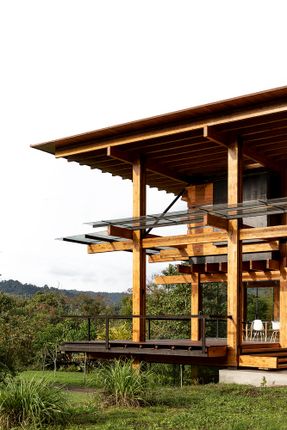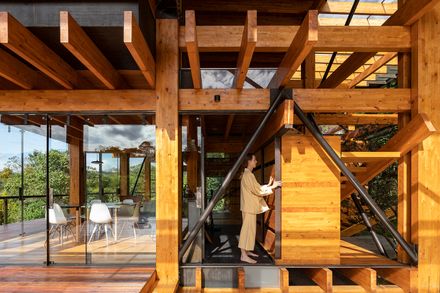Pitaya House
ENGINEERING
Mathieu Lamour
LEAD ARCHITECTS
Martín Real, Florencia Sobrero, Jose María Sáez
CATEGORY
Houses
CONSTRUCTION
Taller General, Jose María Saez, Estefanía Jácome
COLLABORATION
Madebu, Rothoblast Ecuador, Santiago León
The project’s objective was to generate a holiday house that establishes an intimate relationship with nature while maintaining a good connection with the outside. A house that combines these two complexities and proposes an alternative to everyday life.
The house is located in Mindo, a town in the humid forest of the Ecuadorian Andes in an area known as “Chocó Andino”, this area is characterized by heavy rainfall, warm weather and high humidity.
This house was conceived as a biodiverse container that seeks to generate a relationship between the natural and the artificial.
Considering the natural as the flora and fauna from Mindo and the artificial as that which focuses on solving the daily needs of its users (technology, connectivity, leisure, comfort). In this way, it was sought that the house fosters a diverse habitat.
A strategic location on the terrain was chosen, which allowed taking advantage of visuals and generated a harmonious relationship between the height of the house and the surrounding elevations.
In addition, different scales of the inside-outside relationship were achieved with the location, which allowed the program to be distributed according to the spatial needs established for each area with the outside.
Regarding the material, it was decided to work with CLT (Cross Laminated Timber) pieces of pine wood, seeking to promote the use of this emerging construction system in Ecuador. Madebú -the material’s supplier- works with three optimal dimensions (in relation to waste).
In terms of the width of the pieces (11, 3.5 and 7.5 centimeters), in relation to the height we could work with multiples of 3 centimeters, and for the length the limit was given by the transport capacity and handling of the pieces.
It was then decided to use the 3 width available (for the main structure, secondary structure and accessories) always with a height of 30 centimeters and a maximum length of 9.5 meters (because the largest truck that could access the lot had 9.5 meters length).
Another condition for the size of the pieces was the weight, the weight of the longest piece is 145 kilograms approximately. Due to the complicated accessibility to the site, the assembly had to be manual; because of this the pieces were to be transported by a team of 6 people.
Moreover, the maximum length of the pieces defined the height of the house. As a requirement, the columns had to be a continuous pieces, so the maximum height of the house is equal to the maximum length. This condition does not limit the beams because these elements could have connections.
As for the foundation, the terrain was carved generating two platforms at different levels. On these platforms a systematic structure of CLT pieces was supported; these pieces have a 30x11cm section and variable lengths. The columns here are made up of two pieces of this section that embrace the longitudinal beam and this, in turn, allows to support of the cross beam.
To generate the internal spaces, a new element was used, which we called a “free radical” and allowed us to break the order of the main structure to respond to the spatial needs according to the program.
Regarding the program, we sought a house that could change depending on its use. This house could adequately serve the family but could also accommodate more users and diverse activities.
Taking advantage of the climate of Mindo, it was established that the comfort conditions for the family are not necessarily the same as for the visitors.
The family will occupy the house for long periods of time so we thought of capsules that could be isolated from the context and offer good comfort quality. However for visits, understanding them as sporadic users, they could occupy the space in a more informal way.
The house could accommodate many visitors but won’t have guest rooms. Instead, there are many intermediate spaces, attached to the capsules for family use. These capsules can expand their occupancy capacity and be enabled according to their needs.
These intermediate spaces also serve as circulation areas, taking advantage of the privileged views and allowing infinite ways of occupying the house. In addition, they will allow the user to model the scale of each capsule according to their needs. Any room in the house can grow, using these intermediate spaces when required.


















































